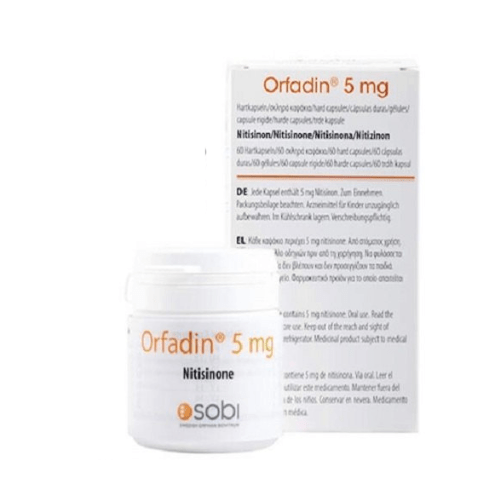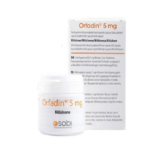About Orfadin
- The active substance present in Orfadin is Nitisinone which is used in the treatment of hereditary tyrosinemia type 1 (HT‑1) in all age group patients who also follow diet restrictions and alkaptonuria (AKU) in adults.
- It occurs when the body is unable to break down certain amino acids. As a result, toxic substances are produced which can cause liver problems and liver cancer in patients with HT-1 and joint problems in patients with AKU.
- Patients with HT-1 and AKU are short of enzymes that break amino tyrosine and as a result, it is converted to toxin. The active substance Nitisinone blocks the enzymes that convert tyrosine into toxins.
- Orfadin is a prescription medicine and treatment should be started under the supervision of an experienced doctor.
Strength:
- Capsules: 2 mg, 5 mg, 10 mg, 20 mg
- Oral suspension: 4 mg/mL
Recommended Dosage:
- The dosage of Orfadin initially is 0.5 mg/kg orally twice daily.
- Dose is titrated based on biochemical and/or clinical response.
- Dose of Nitisinone should be adjusted individually and the plasma and/or urine succinylacetone concentrations, liver function parameters and alpha-fetoprotein is monitored.
- If succinylacetone is detected one month after the start of nitisinone treatment, the dose should be increased to 0.75 mg/kg twice daily.
- A maximum dosage of 1 mg/kg orally twice daily may be needed based on biochemical parameters and body weight gain.
- For patients with HT-1, the recommended starting dose of Orfadin is 1 mg/kg of body weight daily. The dose is then adjusted according to the patient’s response and weight.
- For adults with AKU, the recommended dose is 10 mg daily.
- Maintain dietary restriction of tyrosine and phenylalanine while taking Orfadin.
- For Capsules, taken one hour before or two hours after a meal and for those who have difficulty swallowing and are intolerant to the oral suspension, the capsules may be opened and the contents mixed in a small amount of water, formula, or apple sauce immediately before use.
- For oral suspension it should be taken without regard to meals.
Warnings & Precautions
- In case of leukopenia and severe thrombocytopenia the platelets and white blood cells should be monitored.
- Plasma tyrosine levels should be monitored in patients with an abrupt change in neurologic status.
- Observe for adverse reactions due to the presence of glycerol in Orfadin composition
- In patients with elevated plasma tyrosine levels, ocular symptoms, developmental delay, and hyperkeratotic plaques, Inadequate restriction of tyrosine and phenylalanine can lead to elevations in plasma tyrosine, which at levels above 500 micromol/L which can result in intellectual disability and developmental delay or painful hyperkeratotic plaques on the soles and palms;
- Do not adjust the Orfadin dose to lower the plasma tyrosine concentration.
Common Orfadin Side Effects
- Elevated tyrosine levels
- Thrombocytopenia
- Leukopenia
- Conjunctivitis
- Corneal opacity
- Keratitis
- Photophobia
- Eye pain
- Blepharitis
- Cataracts
- Granulocytopenia
- Epistaxis
- Pruritus
- Exfoliative dermatitis
- Dry skin
- Maculopapular rash
- Alopecia
Use in Specific Population
Pregnancy: Limited data on Nitisinone is available in pregnant women and is not sufficient to inform any drug-associated risk.
Pediatric use: Plasma and urine succinylacetone levels should be monitored are recommended in pediatric patients to ensure adequate control. A skilled nutritionist to manage inborn errors of metabolism should be hired to create a tyrosine and phenylalanine deficient low protein diet.
Storage and Handling
Orfadin white capsules:
- The capsules are packed in a high-density polyethylene container with a tamper-resistant low-density polyethylene cap.
- Store refrigerated at 2° to 8°C (36° to 46°F).
- Orfadin capsules at room temperature up to 25°C (77°F) for up to 45 days. And if not used within 45 days, capsules should be discarded.
Orfadin oral suspension: White, slightly viscous opaque suspension.
- The suspension is provided in a 100 mL brown bottle (type III glass) with a white child-resistant screw cap with sealing and tamper.
- Each bottle contains 90 mL oral suspension.
- Store upright, refrigerated at 2°C to 8°C (36°F to 46°F) prior to first use. Do not freeze.
- After first opening, if stored at room temperature (up to 25°C (77°F) for up to 60 days. If not used within 60 days, discard the remaining portion.
For the medicine procurement, we follow a simple four-step process.
- Enquiry about the medicine: When you request information about the medication you require, we will handle your data. Our Named Access Program Support team will contact you within 24 hours to assist.
- Verification Process: In our mission to help patients access medications that may not be approved or readily accessible in their home countries, Sansfro ensures the verification of medicine availability and approval. Additionally, we thoroughly review the patient’s prescription and medical information for accuracy and compliance.
- Sourcing the Medicine: Upon successfully completing the verification process, our team will initiate contact with our network of suppliers to source the required medication for you. Subsequently, our team works diligently to obtain the most favorable quotes for your medicines and oversees the processing of your order.
- Safe Delivery: We will coordinate the secure delivery of your consignment upon approval of the final quote. Our team of logistics specialists is available to provide consignment tracking assistance. Acknowledging that the Named Access Program industry is susceptible to unauthorized channels is essential. To uphold the safe and legal provision of medications, we rigorously adhere to Standard Operating Procedures.
For the importation of medication, we will require the following documents from the patient:
- An authentic prescription copy.
- A proof of identity document.
- Information about the healthcare provider in charge.
- A current residential address.
Once all these documents are provided, the Sansfro team will begin the import license application process. This license is a crucial requirement to facilitate the procurement of the necessary medication upon receiving government approval.
No news found.
About Sansfro
Sansfro is committed to bridging the healthcare gap. Our purpose is to bring hope and healing to patients suffering from rare diseases by linking them with life-saving treatments through our Named Patient Program. Join us in our quest for a better and healthier world.
Know More...FAQ'S
What are the active ingredients of Orfadin?
Orfadin contains Nitisinone which is a 4-hydroxyphenylpyruvate dioxygenase inhibitor indicated for hereditary tyrosinemia type 1 (HT-1) in combination with dietary restriction of tyrosine and phenylalanine.
What are the possible side effects of Orfadin?
The most common adverse reactions are elevated tyrosine levels, thrombocytopenia, leukopenia, conjunctivitis, keratitis, photophobia, blepharitis, granulocytopenia, epistaxis, pruritus, exfoliative dermatitis, dry skin, maculopapular rash, alopecia, corneal opacity, eye pain, and cataracts.
Which indication Orfadin is used for?
Orfadin is indicated as an adjunct to dietary restriction of tyrosine and phenylalanine. It is a synthetic reversible inhibitor of 4-hydroxyphenylpyruvate dioxygenase and is used in the treatment of hereditary tyrosinemia.
What is cost of Orfadin in India?
For enquiry related to Orfadin price kindly reach out to our Patient Support Team at (+91) 9315705373 or help@sansfro.com
How Orfadin oral suspension is stored?
Store upright, refrigerated at 2°C to 8°C (36°F to 46°F) prior to first use. After first opening, if stored at room temperature (up to 25°C (77°F) for up to 60 days. If not used within 60 days, discard the remaining portion.

Dr Anchal Aryan
Medical counselor
Patient Stories
Word Wide Delivery:
India, Andorra, Argentina, Australia, Austria, Azerbaijan, Bahrain, Brazil, Bulgaria, Cambodia, Canada, Chile, Colombia, Costa Rica, Croatia, Cyprus, Denmark, Dominican Republic, Estonia, Finland, France, Georgia, Germany, Ghana, Greece, Guatemala, Iraq, Ireland, Israel, Italy, Jamaica, Japan, Jordan, Kenya, Kuwait, Latvia, Lebanon, Libya, Lithuania, Malawi, Mexico, Montenegro, Nepal, Netherlands, New Zealand, Nigeria, Norway, Oman, Pakistan, Paraguay, Peru, Poland, Qatar, Romania, Saudi Arabia, Serbia, Singapore, Slovenia, Spain, Sri Lanka, Sweden, Switzerland, United Arab Emirates, United Kingdom, United States, Venezuela, Zimbabwe, Afghanistan, Albania, Algeria, American Samoa, Angola, Anguilla, Antarctica, etc.



